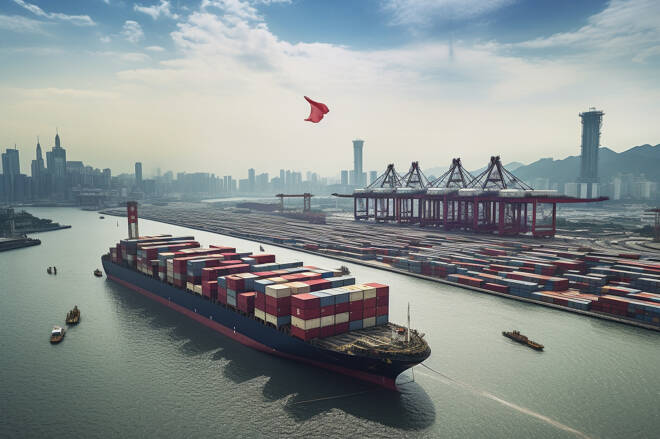Advertisement
Advertisement
China GDP Holds at 5.2%, but Retail and Trade Risks Raise Stimulus Bets
By:
Key Points:
- Q2 GDP rose 5.2%, above Beijing’s 5% target, but soft retail data and deflation highlight fragile economic momentum.
- China’s retail sales growth slowed to 4.8% in June, signaling weakening domestic demand amid rising deflation risks.
- Hang Seng Index rose before retreating, as hopes for stimulus clashed with concerns over domestic consumption.
China’s Economic Data Sends Mixed Signals
China’s June economic data sent mixed signals, fueling concerns about the impact of tariffs and the resilience of the domestic economy. Key indicators included housing prices, retail sales, industrial production and Q2 GDP.
Housing prices declined 3.2% year-on-year (YoY) in June, easing from a 3.5% drop in May. However, prices still fell on a monthly basis, keeping the sector under pressure.
Retail sales increased 4.8% YoY in June, slowing from May’s 6.4% rise, echoing June’s inflation data that signaled weakening domestic demand.
In contrast, industrial production accelerated, rising 6.8% YoY in June, up from 5.8% in May. This uptick aligned with China’s Caixin Manufacturing PMI, which climbed above the 50 neutral level in June.
Despite subdued consumer activity, the pickup in private sector output bolstered China’s economy. The economy expanded by 5.2% YoY in Q2, below Q1’s 5.4% but above Beijing’s 5% growth target.
Trade Data and the Tariff Landscape
The latest figures followed June’s trade report, which showed signs of improving external demand. Exports rose 5.8% YoY in June, up from 4.8% in May, while imports recovered, climbing 1.1% (May: -3.4%). The trade report highlighted China’s adherence to the 90-day US trade war truce.
Crucially, rare earths exports surged 60.3% YoY to 7,742 tons in June, the highest since 2009. June’s surge starkly contrasted with May, when rare earth shipments dropped 74% YoY, including a 93% plunge in exports to the US. China agreed to ease restrictions on rare earth exports in June.
Although tariffs remain, the May 8 trade agreement seemingly eased trade tensions. Exports to the US fell by a more modest 16.1% YoY versus a 43% slump in May.
Meanwhile, Chinese exports to ASEAN countries rose 17% (May: +15%), helping offset falling US exports. However, President Trump’s latest tariff announcements could impact China’s trade terms.
Vietnam agreed to a 40% tariff on transshipments to the US, while Indonesia faces a 32% levy, effective August 1. The tariffs likely target China’s efforts to reroute exports, potentially impacting China’s manufacturing sector and company profits. Weaker profits may further impact labor market conditions, complicating Beijing’s efforts to bolster domestic demand.
David Scutt, market analyst at Stone X, underscored the potential impact of higher tariffs on demand, stating:
“China still making a whole lot of stuff that will need to be sent somewhere given persistent weakness in domestic demand. Hardly seems sustainable.”
Retail and Deflation Concerns
While the manufacturing strengthened, deflation could accelerate in the near term. Consumer prices fell 0.1% MoM in June, and producers reported sharper declines than in May, reflecting increasing competition. June’s weaker retail sales may fuel deflationary pressures, further impacting company profits. Corporate profits slid 9.1% YoY in May. June’s private sector PMIs highlighted a profit margin squeeze as firms cut selling prices to stay competitive.
Combined with tariff-related headwinds, the data may push Beijing to announce further stimulus to stabilize demand and counter external shocks.
Hang Seng Index Eases Back from Morning Highs
Investors reacted to today’s Chinese data, which raised concerns about tariffs, domestic consumption, and Beijing’s 5% GDP target.
The Hang Seng Index was up 0.37% to 24,293 in the morning session, down from an early high of 24,556. However, Mainland China’s markets posted mixed performances. The CSI 300 gained 0.22%, while the Shanghai Composite Index fell 0.36%. Hopes for more stimulus from Beijing cushioned the losses for Shanghai Composite Index, while bolstering demand for Hang Seng Index and CSI 300-listed stocks.
Outlook
Trade remains a key driver, particularly after the sharp rebound in rare earth mineral exports. Overnight, reports that NVIDIA (NVDA) may resume H20 chip sales to China hinted at easing trade tensions. However, relations remain fragile, exposing the Chinese economy and stocks to market volatility.
With trade talks set to resume in July, upcoming economic indicators and stimulus-related news will fuel market sentiment. Natixis Asia Pacific Chief Economist Alicia Garcia Herrero noted ahead of today’s data release:
“2Q will be good but second half will be much tougher so more stimulus is needed. This, however, will not support consumption but infrastructure.”
Her comments highlight the importance of July and August data in determining whether Beijing acts—or holds back.
Follow our coverage as US-China tech tensions reshape global markets and consult our economic calendar.
About the Author
Bob Masonauthor
With over 28 years of experience in the financial industry, Bob has worked with various global rating agencies and multinational banks. Currently he is covering currencies, commodities, alternative asset classes and global equities, focusing mostly on European and Asian markets.
Advertisement
